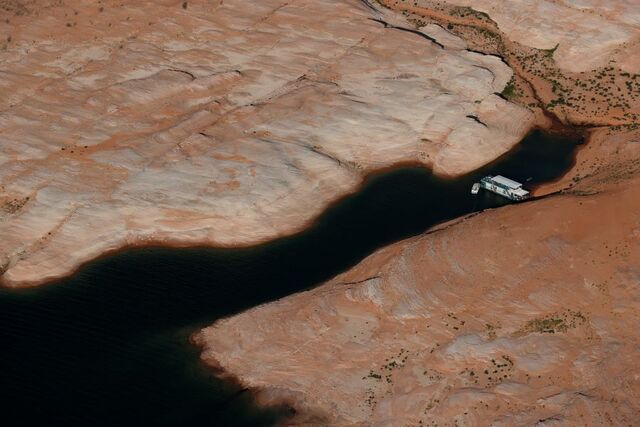I had some choice words for my flip-flops.
My friends and I were only 10 minutes into a hike off the banks of Lake Powell, and I was ready to chuck the good-for-nothing pieces of plastic off a cliff. But because I’d accidently broken my hiking sandals the day before, I had no choice but to wear the dollar store pair of flip-flops that had lived in my duffel bag for years.
We were in southern Utah hiking through the Castle Rock Cut, a “lake shortcut” that usually allows boats to go from Wahweap Bay straight to the main channel of Lake Powell, saving more than an hour of travel time. But because the lake’s water levels are so low this year, the cut has no water in it and is unusable by boat. One of my friends had brought a metal detector on our trip, and we thought it would be fun to go out and see if we could find any long-lost treasures dropped into the cut by the boaters who have passed over the lake through the years. I assumed that after months of being exposed to the scorching hot Utah sun, the ground would be bone-dry.
But I was wrong—and paying for it.
Despite daily temperatures over 100°F, large sections of the cut were nothing but gooey, sticky, shoe-sucking mud. I could barely take a step without my cheap flip-flops being yanked from my foot. Eventually, the straps broke loose from the soles, and I had to try and resecure them every two or three steps.
As my friends walked (and I hobbled) through the cut, someone looked at the canyon walls rising on either side of us and made a comment that it felt like we were walking behind Moses after he parted the Red Sea. We laughed in agreement and kept walking. But as I thought more about what my friend had said, I remembered something that made me stop short—and not because my shoe was stuck in the mud again.
Into my mind came a line from Exodus 14:
“Moses stretched out his hand over the sea; and the Lord caused the sea to go back. . . and the children of Israel went into the midst of the sea upon the dry ground: and the waters were a wall unto them on their right hand, and on their left,” (Exodus 14:21-22, emphasis added).
Wait, wait, wait. Dry ground? The waters of the Red Sea hadn’t been up off the ground for very long yet! The ground I was walking on in southern Utah had been baking in the sun for months and it still wasn’t dry, but Moses and his people were able to walk through almost immediately?
Moses parting the Red Sea just became a much bigger miracle than I’d realized.
As I thought about it more, I realized that of course the ground would’ve needed to be dry—how else would the children of Israel have been able to pull their carts and animals along fast enough before the Egyptians caught up with them?
Over my next few steps of squashing through the mud, I found myself wondering about Moses and his followers. Did they realize they were walking not just through, but on top of a miracle? In the rush to escape, did they realize to what extent the Lord had made their flight to safety possible?
Then, to my surprise, I heard the Spirit whisper back at me, Do you?
Do We Realize We are Walking On Miracles?
I may not have been saved from walking across squelching mud that day at the lake, but all of us can walk through to safety in a much more important spiritual sense. The story of Moses parting the Red Sea is now, to me, a story of God’s thoroughness. Through the Restoration of the gospel and priesthood keys, Heavenly Father has provided everything we need to walk back safely to our heavenly home. Through the Savior’s love and sacrifice, all of our spiritual needs can be met. Because He’s thought through every detail, we can walk on dry ground.
In his most recent conference address, President Dallin H. Oaks said, “What has Jesus Christ done for each of us? He has done everything that is essential for our journey through mortality toward the destiny outlined in the plan of our Heavenly Father.”
Do we, like the children of Israel following Moses, realize what Lord has made possible for us? I know I am sometimes guilty of what Elder Dieter F. Uchtdorf noticed when he said, “We tread a path covered with diamonds, but we can scarcely distinguish them from ordinary pebbles.” Keeping our daily walk in perspective (avoiding become myopic as President Nelson has taught) takes practice and effort, but doing so will help us feel Heavenly Father’s love as we recognize and remember the infallible goodness of His plan.
Each of us have been called to cross our own “Red Sea” in this life. And while that journey will undoubtedly be difficult—the Israelites didn’t have it easy once they made it past the Red Sea—it is gloriously possible. And that is a miracle! The plan of salvation is happening right under our feet. Every day we walk on the precious truths of eternal families, the guidance of living prophets, life after death, repentance, forgiveness, and so much more.
In 2 Nephi 10 we read, “Therefore, cheer up your hearts, and remember that ye are free to act for yourselves—to choose the way of everlasting death or the way of eternal life.”
As we strive to walk this path toward eternal life, I hope we’ll remember to look down every now and again and give thanks for how beautifully reliable this path of diamonds is.
► You may also like: What we may be misunderstanding in the Savior's command to ‘Doubt not, fear not’
Editor's note: This article originally ran on LDSLiving.com in June 2021.


